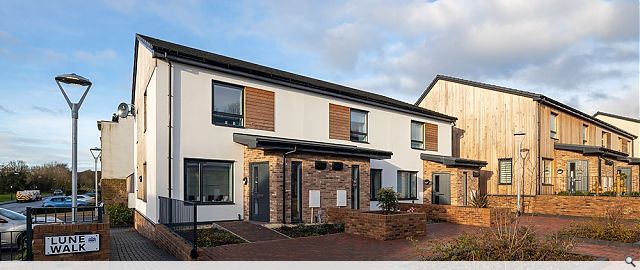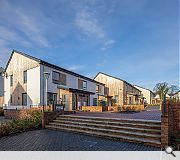Halton
Lune Valley Community Land Trust (CLT) and South Lakes Housing are delighted to complete a new development of 20 Passivhaus-standard homes in Halton, Lancaster. The £3.7m project consists of 16 two-storey terrace houses and four cottage flats on either side of a new pedestrian street.
On the brownfield site of a former textile mill, the homes are for a mixture of social let and shared ownership. A key aim of Lune Valley CLT is to deliver more affordable homes in the area – it has already helped to deliver a co-housing scheme, runs and owns a hydro electric power station on the river Lune and an all-electric car share club. The project brief for Halton was to achieve Passivhaus-standard from inception stage for homes design for social let and shared ownership. The great attraction of Passivhaus standard for registered social landlords (RSLs) is the ability to reduce fuel poverty for tenants by providing homes which can be very cheap to heat. The houses are very simple in form, partly for the purpose of maximising their efficiency as Passivhauses: the standard influences every aspect of design. To counter this, a placemaking approach focusses on the nature and quality of the central traffic-free street.
The rows of houses are closer together than is normally permitted by planning guidance, creating a village street atmosphere in the central space, and a community feel is also nurtured by removing fences. The curtilage of each plot and the delineation of public/private open space is subtly indicated by the placing of brick planters. The varied materials, coloured render on board, brick and timber break up the uniformity of the building’s basic volumes. Unheated porches house the mechanical ventilation heat recovery (MVHR) units for ease of access and also help to articulate the terraces. High quality landscaping adds a sense of care and attention to detail. The homes meet Passivhaus standard for new build, achieving an annual space heating demand of less than 15kWh per m2 per year. The space heating and hot water is provided by air source heat pumps – there is low demand and what demand there is is met by renewable sources.
The local power infrastructure from Lune Valley’s hydro scheme has been extended to the corner of the site, this energy is used for electric vehicle charging (six spaces) and street lighting. The project was delivered by a team including Tyson Construction, Elliott Associates, R G Parkin and Partner and WARM.
Back to Housing
- Buildings Archive 2024
- Buildings Archive 2023
- Buildings Archive 2022
- Buildings Archive 2021
- Buildings Archive 2020
- Buildings Archive 2019
- Buildings Archive 2018
- Buildings Archive 2017
- Buildings Archive 2016
- Buildings Archive 2015
- Buildings Archive 2014
- Buildings Archive 2013
- Buildings Archive 2012
- Buildings Archive 2011
- Buildings Archive 2010
- Buildings Archive 2009
- Buildings Archive 2008
- Buildings Archive 2007
- Buildings Archive 2006






